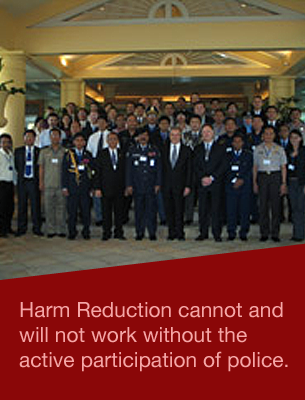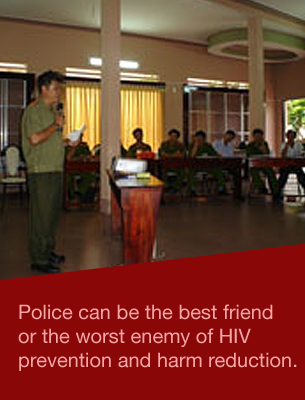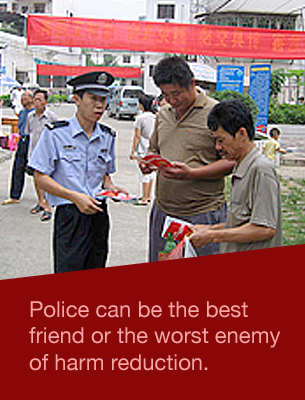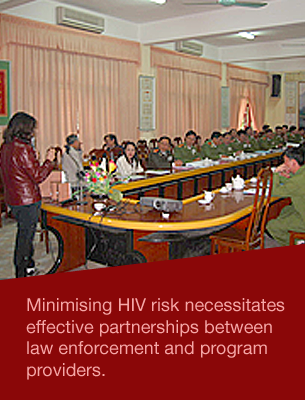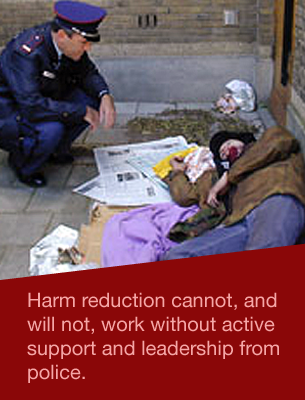Police participation in harm reduction measures that protect public health and serve communities is a growing good news story. It can also play a part in repairing a battered reputation.
Read the original post here on substance.com
A failure to consider the impact of policing on public health has frequently been a missing link between law enforcement and drug policy. Yet responsible, compassionate policing has the potential not only to improve public health, but to help heal the damaged relationship between police and public in the wake of Ferguson, the deaths in New York and many other flashpoints. And responsible, compassionate policing means harm reduction.
The opposition continues to claim that harm reduction programs—including syringe exchange, supervised injection facilities, medication-assisted treatment (MAT) and heroin-assisted treatment (HAT), even the distribution of naloxone to reverse overdoses—“send the wrong message” to our children by “condoning” the use of drugs. These views are based largely on the unscientific stigmatization of substance use and a lack of acceptance of law enforcement’s ethical obligation to reduce drug-related harms, not just breaches of the law.
Sadly, law enforcement has often vigorously led such opposition to harm reduction programs, which are generally supported by overwhelming evidence. In 2008, for example, the International Association of Chiefs of Police (IACP) gathered in San Diego for its 115th annual conference. The conference passed a resolution stating that the IACP “strongly opposes ‘harm reduction’ policies and supports law enforcement, prevention, education and treatment policies that result in the rejection of drug use. ”
The IACP’s stated rationale included that “the adoption of ‘harm reduction’ policies sends a message, particularly to young people, that drug use is ‘normal’ behavior,” and that “’harm reduction’ policies negate the value and effectiveness of law enforcement … by perpetuating defeatist attitudes that drug use is an unavoidable aspect of the ‘human condition’”
Such rhetoric, still heard far too often in law enforcement circles, ignores the proven efficacy of harm reduction programs at protecting both people who use drugs and public safety professionals, while enhancing positive public health outcomes—including the reduction of crime. Instead, the singular focus on supply-side enforcement has helped to perpetuate a groupthink mentality.
We can draw strength from our knowledge that police opposition to harm reduction is in distinct contrast to much of the history of law enforcement.
Law Enforcement Against Prohibition (LEAP), a group of criminal justice professionals opposed to the war on drugs (of which I am a board member), has helped to push the policy discussion in the opposite direction, by articulating that one of the many consequences of drug prohibition is its contribution to death, disease and addiction in our communities.
We can draw strength from our knowledge that police opposition to harm reduction is in distinct contrast to much of the history of law enforcement. For example, Chief August Vollmer, Berkeley police chief from 1909 to 1923, is recognized as a leader who helped to professionalize policing through the application of scientific principles not only to solve crime, but to work in service of our communities. Vollmer, who at one time was also president of the IACP, established the first School of Criminology at the University of California at Berkeley (1916), where he introduced a curriculum that emphasized the link between policing, science and public health. Vollmer famously stated:
“Drug addiction, like prostitution and like liquor, is not a police problem; it never has been and never can be solved by policemen. It is first and last a medical problem, and if there is a solution it will be discovered not by policemen, but by scientific and competently trained medical experts whose sole objective will be the reduction and possible eradication of this devastating appetite. There should be intelligent treatment of the incurables in outpatient clinics, hospitalization of those not too far gone to respond to therapeutic measures, and application of the prophylactic principles which medicine applies to all scourges of mankind.”
His enlightened views on the nexus between substance use, social problems and science spanned measures that we would now recognize as harm reduction to prevent crime, including medication-assisted treatment for opioid addicts. He promoted a policy that would have required the government to dispense opioids to those with chronic opioid problems, similarly to what we’ve seen with methadone or suboxone in this country, or the successful HAT programs in places such as Switzerland.
Happily, despite law enforcement’s more recent opposition to harm reduction, the conversation is rapidly changing. Law enforcement has seen the tragic increase in opioid overdose deaths in recent years, resulting directly from the unregulated drug market, deaths that starkly illustrate, once again, the failures of our current system. A positive outcome of this tragedy has been scores of innovative measures across the country, with some law enforcement leaders taking bold steps to address the police role in supporting harm reduction while still working within the law.
So I have real hope that despite the continued opposition of most of law enforcement to ending prohibition, it is finally becoming clear that we cannot incarcerate our way out of America’s drug problem.
Despite the perceived conflicts between public health and policing, many agencies advocate for the use of harm reduction initiatives as part of their community policing strategies. Notable examples include the successful implementation, since 2011, of Law Enforcement Assisted Diversion (LEAD) programs in King County, Washington and Santa Fe, New Mexico. LEAD gives officers the ability to connect low-level, nonviolent drug dealers and drug users with treatment and services as a pre-booking diversion alternative to jail. Is LEAD a perfectantidote to prohibition? No—some critics have described it as “coercive.” But it is a huge step forward, and “any positive change” is what harm reduction is all about.
Not long ago I interviewed former Seattle Police Chief Jim Pugel, who oversaw the introduction of LEAD, about the program. He emphasized and believes, as I do, that “helping addicted people out of crime and disorder into a safer place for all is a measure of a caring society, and certainly a caring police department.”
LEAD is focused on the health of both the community and the individual. By taking a holistic approach to problematic drug use, LEAD recognizes that abstinence and relapse are part of a complex issue and that other metrics are more valuable than positive or negative drug screenings. This example of a coherent link between public health and policing has changed and improved public safety, reducing both criminality and the harms of drug use.
Even if we can’t all agree right now on ending prohibition, we can arrive at a shared commitment to saving lives.
But it’s not just LEAD that is changing the nature of policing. It’s also the collaboration of drug policy reformers, both grassroots activists and legislators, to push laws designed to prevent drug overdose deaths. The passage of more state Good Samaritan and naloxone access laws has contributed to a growing acceptance by law enforcement of its role in promoting positive health outcomes.
The naloxone program launched by the police department of Quincy, Massachusetts, for example, was once considered novel—risky, even. But it has now saved 300 lives and counting, and is being imitated across the country. Naloxone in the hands of the police, who are frequently the first responders at the scene, has fueled a drug-war paradigm shift. Even the Office of National Drug Policy (ONDCP) has noted this—increasingly using harm reduction language in discussing future drug control strategies, and sending its acting head, Michael Botticelli, to address the national harm reduction conference in Baltimore a few months ago.
So are we on the brink of making peace with drugs? Despite the many gains we have made, the largest impediments to dismantling the drug war remain the stigmatization of substance use and a political over-reliance on enforcement. Yet even if we can’t all agree right now on ending prohibition, we can arrive at a shared commitment to saving lives.
I believe that the work of organizations like LEAP and many others has forced law enforcement to start to re-think its attitude. I believe that the future role of law enforcement can more closely resemble that envisioned by Chief Vollmer. An emphasis on a multi-disciplinary approach to policing, based on science, harm reduction, compassion, common sense and a respect for human rights is possible. By seizing the chance to embrace new attitudes and policies, by taking a lead on safeguarding public health, modern American law enforcement can do a huge amount of good—and radically overhaul its reputation to boot.
Lieutenant Commander Diane Goldstein (Ret.) is a board member of Law Enforcement Against Prohibition, a group of law enforcement officials opposed to the war on drugs. Her last piece for Substance.com addressed why the reduced power of law enforcement to influence politics through lobbying is a good thing.




